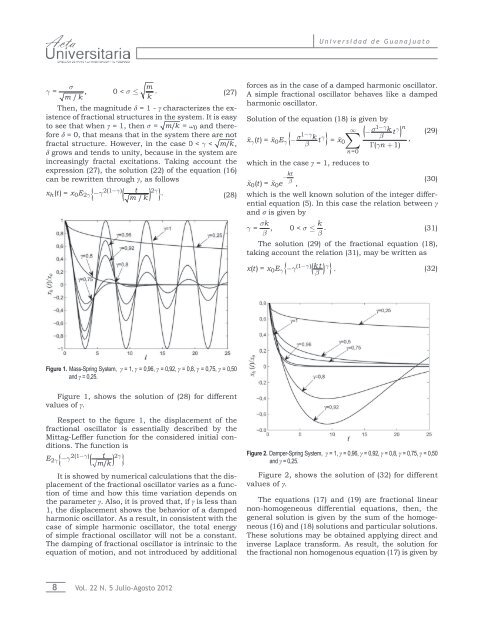A fractional calculus approach - Redalyc
A fractional calculus approach - Redalyc
A fractional calculus approach - Redalyc
Create successful ePaper yourself
Turn your PDF publications into a flip-book with our unique Google optimized e-Paper software.
σ<br />
m<br />
γ = , 0< σ ≤ . (27)<br />
m / k<br />
k<br />
Then, the magnitude δ = 1 - γ characterizes the existence<br />
of <strong>fractional</strong> structures in the system. It is easy<br />
to see that when γ = 1, then and therefore<br />
δ = 0, that means that in the system there are not<br />
fractal structure. However, in the case ,<br />
δ grows and tends to unity, because in the system are<br />
increasingly fractal excitations. Taking account the<br />
expression (27), the solution (22) of the equation (16)<br />
can be rewritten through γ, as follows<br />
8<br />
Vol. 22 N. 5 Julio-Agosto 2012<br />
. (28)<br />
Figure 1. Mass-Spring System, γ = 1, γ = 0,96, γ = 0,92, γ = 0,8, γ = 0,75, γ = 0,50<br />
and γ = 0,25.<br />
Figure 1, shows the solution of (28) for different<br />
values of γ.<br />
Respect to the figure 1, the displacement of the<br />
<strong>fractional</strong> oscillator is essentially described by the<br />
Mittag-Leffler function for the considered initial conditions.<br />
The function is<br />
It is showed by numerical calculations that the displacement<br />
of the <strong>fractional</strong> oscillator varies as a function<br />
of time and how this time variation depends on<br />
the parameter γ. Also, it is proved that, if γ is less than<br />
1, the displacement shows the behavior of a damped<br />
harmonic oscillator. As a result, in consistent with the<br />
case of simple harmonic oscillator, the total energy<br />
of simple <strong>fractional</strong> oscillator will not be a constant.<br />
The damping of <strong>fractional</strong> oscillator is intrinsic to the<br />
equation of motion, and not introduced by additional<br />
Universidad de Guanajuato<br />
forces as in the case of a damped harmonic oscillator.<br />
A simple <strong>fractional</strong> oscillator behaves like a damped<br />
harmonic oscillator.<br />
Solution of the equation (18) is given by<br />
which in the case γ = 1, reduces to<br />
Figure 2. Damper-Spring System, γ = 1, γ = 0,96, γ = 0,92, γ = 0,8, γ = 0,75, γ = 0,50<br />
and γ = 0,25.<br />
,<br />
(29)<br />
kt<br />
x0()= t x0e β<br />
−<br />
(30)<br />
̃ ̃ ,<br />
which is the well known solution of the integer differential<br />
equation (5). In this case the relation between γ<br />
and σ is given by<br />
σk<br />
k<br />
γ = , 0< σ ≤ . (31)<br />
β β<br />
The solution (29) of the <strong>fractional</strong> equation (18),<br />
taking account the relation (31), may be written as<br />
. (32)<br />
Figure 2, shows the solution of (32) for different<br />
values of γ.<br />
The equations (17) and (19) are <strong>fractional</strong> linear<br />
non-homogeneous differential equations, then, the<br />
general solution is given by the sum of the homogeneous<br />
(16) and (18) solutions and particular solutions.<br />
These solutions may be obtained applying direct and<br />
inverse Laplace transform. As result, the solution for<br />
the <strong>fractional</strong> non homogenous equation (17) is given by

















